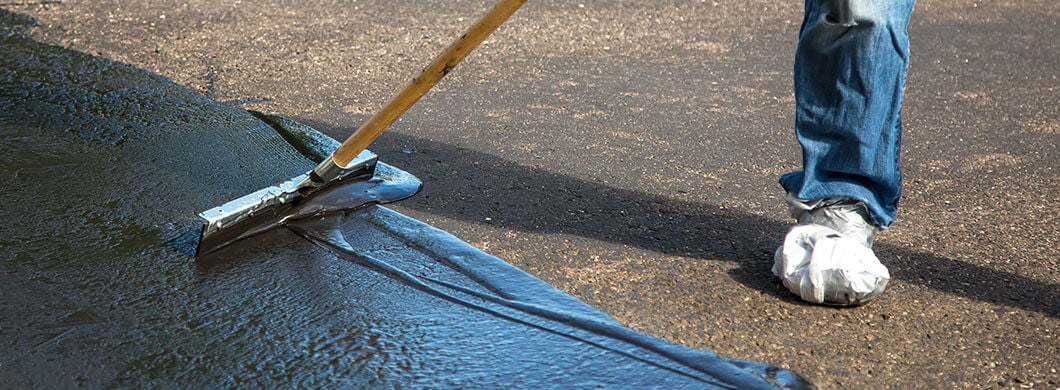Facing the challenges of weather, asphalt repair tips become crucial. The harsh weather can take a toll on asphalt roads, parking lots, and roofing. Rapid ground expansion and contraction due to drastic temperature changes cause cracks and potholes. Prolonged sun exposure results in fading and deterioration. Heavy rainfall can seep into tiny asphalt cracks and produce structural damage. Road salt that fights the build-up of ice and snow during the winter months can eat away at the surface of your parking lot. The list goes on. We need asphalt repair!
Asphalt parking lots, roads, and roofing are constantly suffering wear and tear. Damage is inevitable, but preventive pavement maintenance and repair can minimize the extent of the damage and save you lots of frustration, time, and money in the future. Here are five asphalt repair tips that will mitigate severe damage and increase longevity.
1. Asphalt Repair for Surface Damage
When assessing the overall condition of your asphalt repair for a parking lot, road, driveway, or roof, it may be tempting to overlook small surface damage like tiny cracks and depressions. Severe damage to any asphalt pavement should be your priority and quickly addressed, but this does not mean that you should neglect little issues. On the contrary, rigorously repairing less significant structural damage is how you prevent massive problems in the future. Tiny cracks and depressions will quickly grow into more significant issues because they are more susceptible to further wear and tear. An asphalt depth gauge may help you determine the level of deterioration and the severity of damage that your asphalt pavement has incurred.
In the long run, fixing small damages is key to preventive pavement maintenance and will prevent big, expensive structural failures. A simple crack fill or skin patch is usually enough to keep small damages under control, and the long-term benefits are well worth the time and effort.
2. Overall Damage May Not Require Total Asphalt Repair Replacement
Pavement that has sustained massive damage or deterioration over its entire asphalt surface can seem like a hopeless situation. The time, effort, and cost of repairing so many issues can be daunting and impossible to overcome. As a result, many people will automatically decide to have the entire asphalt parking lot, road, or driveway completely replaced. Indeed, some asphalt pavements are beyond repair. However, overall damage does not require total replacement in every circumstance. In fact, most asphalt pavements that have sustained overall damage can be repaired with an asphalt or fabric overlay.
Each overlay application adds a new layer of pavement to the top of your asphalt parking lot, roof, or driveway. You can add new life to old asphalt without the huge cost typically associated with a total pavement replacement.
Asphalt or Fabric Overlay on Pavement Step-By-Step Process:
- Repair existing distresses and damage in asphalt repair
- Remove loose material or water from the pavement
- Apply a new layer of asphalt OR lay down geotextile fabric material and then apply a new layer of asphalt (a fabric overlay adds extra strength to your pavement)
- Compact and smooth the new layer of asphalt
- Add parking stall striping, arrows, speed bumps, directional lines, signage, and more
In the end, an asphalt or fabric overlay will improve the appearance and durability of your pavement and save you a lot of time and money. Overlays are a much more affordable alternative to full removal and replacement of your paved surface. Unlike total replacement, pavement overlays can be completed within a few days and will minimize downtime for your road or parking lot.
3. Look for Separation Between Asphalt Pavement and Structures
Water damage can cause the asphalt pavement to sink or rise through the natural pressures of expansion and contraction. When an asphalt pavement sinks or rises against concrete gutters, edgings, and sidewalks an unlevel surface can form. In other cases, the asphalt surface separates and moves away from these adjacent structures and leaves a large gap.
Uneven surfaces and large gaps between the asphalt pavement and adjacent structures is a serious issue because it allows for further, more severe damage to occur and it can be a trip and fall hazard. Unlevel surfaces and separation gaps can be fixed using asphalt milling and wedging tools. This process and equipment can repair the problem and improve drainage on the asphalt pavement to prevent similar damage in the future.
Fixing unevenness and separation damage will mitigate a costly problem and will significantly reduce the risk and liability of people tripping and falling.
4. Cut, Remove, and Replace Asphalt Damage that You Cannot Easily Fix
Some asphalt surface or structural damage cannot be repaired with a simple patch or crack fill. When faced with this type of asphalt challenge, total replacement is not your only option. Repair is still possible. However, severe asphalt pavement problems will require more extensive and aggressive solutions. To monitor and measure the severity of cracks in an asphalt surface and pavement, consider purchasing asphalt testing equipment to assist you in determining repair solutions.
Severe asphalt deterioration due to water or other factors must be cut out, removed, and replaced with new asphalt. This process begins by cutting around the distressed area with a heavy-duty saw. Defective asphalt is then removed and discarded. In some cases, the deterioration will affect the subgrade or foundation of the pavement structure. If the subgrade is damaged, base materials such as ABC or GSA should be added and compacted to support the new surface of asphalt. Once the subgrade is structurally sound, the new layer of asphalt is applied.
Cutting, removing, and replacing defective asphalt is a more extensive repair. However, it is less expensive than completely replacing your parking lot, road, driveway, or roof. This process of repair will improve drainage, ensure durability, and promote safety at a smaller cost.
5. Protect Your Asphalt Pavement from the Sun
UVA and UVB rays from the sun can greatly damage an asphalt pavement. Constant exposure can produce a cracked and faded surface. To reverse and prevent deterioration due to sun damage, consider asphalt sealing as a repair solution.
Asphalt Sealants to Mitigate Sun Damage When Applied to Surface:
- Seal Coat: Anti-oxidation additives within this asphalt sealant reduces raveling and helps to reduce damage from the sun. Out of all other available treatment, this is the most cost-effective solution to protecting an asphalt surface from harmful UVA and UVB rays.
- Slurry Seal: This treatment primarily fixes asphalt cracks due to damage from the sun and other elements. It is less focused on prevention and more oriented towards providing instant improvements in pavement appearance. The thicker aggregate within this treatment fills in fine lines that occur over time.
- TRMSS: Tire Rubber Modified Surface Seal (TRMSS) acts as a moisturizer for dry asphalt pavement that is regularly exposed to hot temperatures and the heat of the sun. It seeks to protect and prolong the life of asphalt pavement by replenishing natural surface oils and preventing damage due to oxidation, weather, and day-to-day traffic.
- Microsurfacing: This fast-acting treatment utilizes polymers and residual content to create a “like new” surface that is free of the visible signs of sun damage. Within an hour of its application, microsurfacing treatment can produce tangible results.
For more asphalt repair tips or to learn more about certified material testing products, call or contact Certified MTP.
Related Blogs for Asphalt Repair:
Top Asphalt Testing Solutions for Pavement Performance
Asphalt Testing Equipment: A Comprehensive Guide
Mastering Marshall Testing: A Guide for Quality Asphalt
Benefits of Asphalt Mixer: Mixing Asphalt for Construction
All You Need to Know About Asphalt Thermometers
Asphalt Testing: Equipment, Solutions, and Engineering
The Importance of Asphalt Density in Pavement Construction
Asphalt Depth Poker – A Comprehensive Guide
Ignition Oven: A Guide to NCAT Asphalt Content Furnace Tech
Discover the Best Asphalt Core Drill Bit for Your Project
Benefits of Asphalt Binder: A Comprehensive Guide
Rice Testing: Guide to Asphalt Specific Gravity Testing
The Best Guide to Coring Test for Asphalt & Concrete Cores
Understanding the Marshall Test for Asphalt Mix Design
Understand Viscosity of Asphalt: Dynamic and Kinematic
Essential Asphalt Testing for the Road Surface
Asphalt Testing Equipment: A Comprehensive Guide
Asphalt vs Concrete: A Comparative Study
Asphalt Rice Testing: Understanding the Equipment and Tests
Understanding the Specific Gravity of Asphalt
Factors That Influence the Quality of Asphalt: 21 Keys
Determining the Specific Gravity of Asphalt with Rice Test
Marshall Test: Comprehensive Guide to Asphalt Testing
Asphalt Testing: From Materials Testing Experts
Top Choice for Bulk Rubber Hose: Durability And Flexibility

